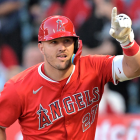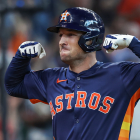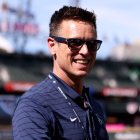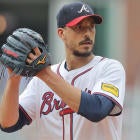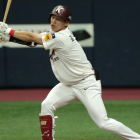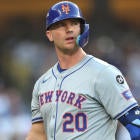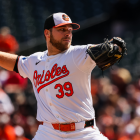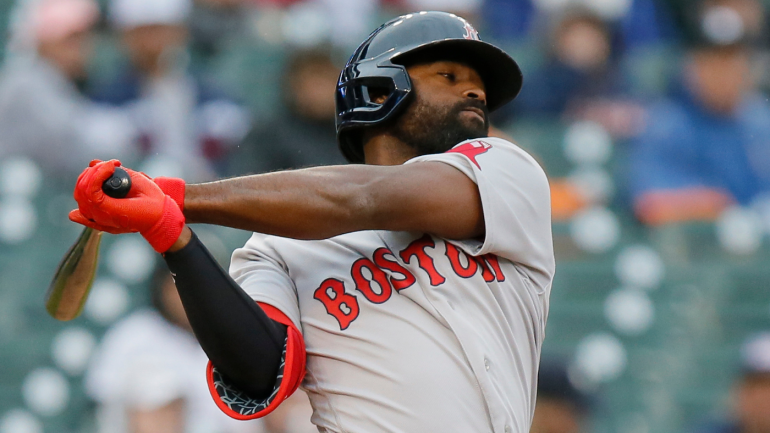
The 2022 MLB regular season is roughly a month old and although I know no one wants to hear it, it's still early. How early? So early that there is still a qualified pitcher with a sub-1.00 ERA. That pitcher: Logan Gilbert at 0.64. As a rule of thumb, you can keep saying it's still early as long as someone has a sub-1.00 ERA.
With that in mind, our weekly series breaking down various trends across the league continues Wednesday with a look at one team's bottom-of-the-lineup problems, a pitcher's velocity spike, and the strikeout rate in the low minors. Last week we examined Luis Robert's strikeout rate, Eric Lauer's velocity, and baseball's "sweeper" boom.
Boston's bottom-of-the-lineup woes
To call it a disappointing start to the season for the Red Sox would be an understatement. Instead of coming out strong following last year's trip to the ALCS, Boston took a 9-14 record into Tuesday night's series opener with Mike Trout's Angels (which they won, 4-0). They ranked 24th in runs scored per game. Hard to believe a Red Sox team is having that much trouble scoring runs.
The usual suspects are pulling their weight: Xander Bogaerts, Rafael Devers, and JD Martinez have been the club's three best hitters and it's not close either. All are performing at a well above average rate. The rest of the lineup, however, has been dismal. Boston's fourth-best hitter this year has been Alex Verdugo, owner of a .238/.278/.375 line going into Tuesday.
The bottom of the lineup has been particularly dreadful. Historically awful, in fact. Jackie Bradley Jr., Bobby Dalbec, and catchers Christian Vázquez and Kevin Plawecki have occupied the 7-8-9 spots in some order most of the season. That part of the lineup is where rallies go to die. Look where Boston's 7-8-9 hitters rank compared to other 7-8-9s around the league:
| Red Sox | MLB average 7-8-9 hitters | |
|---|---|---|
Batting average | .159 (30th) | .221 |
On-base percentage | .207 (30th) | .292 |
Slugging percentage | .223 (30th) | .335 |
OPS+ | 38 (30th) | 100 |
There's a universal DH now, so the league-wide 7-8-9 hitters aren't being dragged down by pitchers hitting in the National League. Boston's 7-8-9 hitters have been across the board terrible. The next worst collection of 7-8-9 hitters belong to the Pirates, a team that isn't not even pretending to compete in 2022. Their 7-8-9 hitters own a .209/.253/.274 line. That's a 68 OPS+.
The good news is no team in baseball history has had 7-8-9 hitters as bad as the Red Sox's 7-8-9 hitters this year across a full season. The lowest 7-8-9 OPS+ ever belongs to the 1913 St. Louis Browns. Their 7-8-9 hitters hit .189/.260/.246 for a 61 OPS+. More recently, the 2019 Royals got a .215/.272/.318 (68 OPS+) line out of their 7-8-9 hitters. It's unlikely Boston's 7-8-9 hitters will continue to be this bad.
The bad news is there's no easy fix. It's not as simple as benching some guys and playing others, because Boston's bench is lacking thump as well. Top prospect Triston Casas is mashing in Triple-A and only a phone call away. Giving Dalbec's at-bats to Casas might help. There is no outfielder waiting to replace Bradley though, or an offense-first catcher. The best fix is for the guys who currently occupy the 7-8-9 spots to start hitting, which is easier said than done.
"The bottom line is we've got to swing the bats," manager Alex Cora told MassLive.com's Chris Cotillo. "We had a horrible month in April. We didn't do our job. We can talk about, 'It's early' and all that stuff but we have to put better at-bats. That's the bottom line. It seems like we get going and we stop and all of the sudden you look up, it's the seventh or eighth inning and it's a close game. We know we're capable of doing it."
Boston's unproductive bottom of the lineup is a function of design more than anything. Bradley was arguably the worst hitter in the game last year, so what he's doing this year didn't come out of nowhere. Dalbec's contact issues make him a high variance-hitter, one with extreme peaks and valleys. Neither catcher has ever been known as an offensive force. As good as the Red Sox's top hitters are, they're not good enough to carry a bottom of the lineup this bad. Something has to give.
(On the flip side, the Dodgers have had the most productive 7-8-9 hitters in baseball this year. The bottom of their order went into Tuesday with a .270/.338/.470 batting line for a 156 OPS+.)
Cobb's career high velocity
It is rare for a pitcher approaching 35 to add velocity. Velocity typically declines with age because wear and tear builds up and the arm doesn't work the same way it once did. It's perfectly natural. Giants righty Alex Cobb is an exception. This year Cobb is averaging a career best 94.7 mph with his sinker, his primary fastball. His previous career best was 92.7 mph last year.
A graph is worth a thousand words:
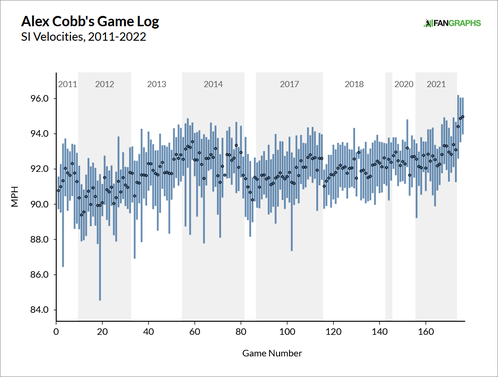
Cobb has made three starts this season around a minor groin injury and in those three starts he managed to throw the 22 fastest pitches of his career, and 29 of the 31 fastest. His 28.0 percent strikeout rate, 12.0 percent swinging strike rate, and 73.3 percent ground ball rate are all well above his career norms, though obvious small-sample-size caveats apply.
Sample-size caveats do not apply to velocity, however. You can fake being a .300 hitter for a week or a month or even an entire season. You can't fake throwing 95 mph though. You can either do it or you can't, and Cobb is doing it now after never doing it in his career up to this point. It is a rare accomplishment even with best training methods humans have ever had.
"That's new to me," Cobb told MLB.com's Maria Guardado after touching 97 mph in an outing this spring. "I think I had one 96 last year, possibly. Each year it's just been kind of creeping up."
Cobb's velocity increase stems from a trip to Driveline Baseball, the famed data-driven training facility in the Seattle area, after the 2020 season. Current Giants teammate Alex Wood, then an offseason workout buddy, pointed Cobb in Driveline's direction. Cobb went to Driveline with the goal of improving his mechanics. He did that and the increased velocity followed.
Here's what Cobb told NBC Sports Bay Area's Alex Pavlovic after signing with San Francisco:
"I rely heavily on my command. I've developed a thought process of trying to make strikes look like balls and balls look like strikes and really nibble on the corners a little bit here and there and disguise pitches," Cobb said. "I went to Driveline after the 2020 season and got to see the effects of that last year. I picked up a couple of ticks on my fastball (last year) and more life on my pitches. The curveball bit a little bit harder, the two-seam took off a little bit more, and the changeup had a little bit more depth to it than I had the previous three years in Baltimore. That was a very encouraging sign for me and I'm continuing it this year.
"Hopefully we'll be able to see those gains going into next year and build off what I did last year. I like to be aggressive. I like to get the ball on the batter's hands and try to get them to put the ball on the ground and let my defense work and have quick innings. I like the pace of the game. Get the defense off their feet and put the bat in their hands and have them go do some work."
The Giants are a smart team, as smart as any team in the game, so it is no surprise they jumped on an undervalued veteran in free agency. Cobb's velocity increase and the overall improvement in the quality of his stuff dates back to last season and contributed to a 2.01 ERA and a .222/.295/.302 opponent's batting line in his final seven starts with the Angels.
Given his age and injury history, it's fair to wonder whether Cobb's newfound velocity will stick all season. Fatigue could become an issue at some point. For now, the Giants might have the best ever version of Cobb, who was a pretty darn good pitcher back in the day with the Rays. Making mechanical adjustments is not easy, but they can pay huge dividends if they work out.
The rising Single-A strikeout rate
It is no secret the MLB strikeout rate has been on the rise the last 25 years or so. Last year's 23.2 percent strikeout rate represents a) the second-highest strikeout rate in MLB history, and b) a decline from the record 23.4 percent in 2020. Last year was the first time the league strikeout rate decreased from one year to the next since 2005.
Strikeouts are also on the rise in the minor leagues, particularly in the lower minors. In fact, they're skyrocketing, and the strikeout rate in the minors is much higher than it is in MLB. Here are the Single-A strikeout rates the last few years. This is the combined strikeout rate for the Low Class-A and High Class-A levels:
- 2017: 22.0 percent
- 2018: 22.5 percent
- 2019: 23.6 percent
- 2020: No minor league season
- 2021: 26.3 percent
- 2022: 27.5 percent
For reference, longtime big leaguer Mike Napoli had a career 27.5 percent strikeout rate. The entire Single-A level is striking out at a Napolian rate this season. Single-A strikeout rates tend to be very high early in the season before coming down as outlier players get promoted and demoted, but we are on track for another record high strikeout rate in the lower minors.
There are two primary explanations for the spike in Single-A strikeouts. The first is MLB's minor-league contraction plan. It is no coincidence the strikeout rate spike arrived in 2021, after the 2020 minor-league season was lost to the pandemic. MLB used the pandemic to accelerate its takeover of the minors, which was really nothing more than a way to cut costs for owners.
As part of MLB's minor-league takeover, the short season Single-A leagues were eliminated. Those leagues served as a stepping stone between rookie ball (the lowest level of professional baseball) and Low Class-A. Short season leagues played 60-ish game seasons with a level of competition that was greater than rookie ball but below Low Class-A.
With the short season leagues eliminated, a lot of players who aren't quite ready for full season ball are being moved up to Low Class-A because they conquered rookie ball and have nowhere else to go. That jump from rookie ball to a 144-game grind in Low-A is significant. Many players who aren't truly ready for it now have to make that jump, and are being exposed.
The second explanation is advancements in pitching development. Pitching is too good these days. Every problem MLB is trying to solve (too many strikeouts, a reliance on home runs, etc.) starts with the pitching being too good. Seemingly everyone throws 95-plus and has a breaking ball that looks like it was designed in a lab (because sometimes it is).
Those developments are not limited to major leaguers. Two weeks ago Wellington Diaz, a righty in the Yankees system, went viral for this mind-bending slider:
Someone should tell @HVRenegades hurler Wellington Diaz of the @Yankees that any pitch turning this sharply needs a turn signal: https://t.co/ICvNnOlwky pic.twitter.com/nd2rRWR0sb
— MLB Pipeline (@MLBPipeline) April 20, 2022
That's a nasty, disgusting, unhittable pitch. And with all due to respect to Diaz, he is not much of a prospect. He is a 25-year-old reliever with a 5.36 ERA at the two Single-A levels since the start of last season. And he's throwing pitches like that. Diaz is not an outlier either. The quality of stuff has improved so much in such a short time in baseball, majors and minors.
Combine developing young hitters (i.e. kids still honing their swing and learning an approach) who are essentially skipping a level (because the short season leagues no longer exist) with modern pitching development and you have a recipe for a massive jump in strikeout rate in the low minors. This is not a blip. This is a confluence of several factors, all working against hitters.
I'd like to think this low minors strikeout rate trend will reverse at some point, but MLB is already looking to cut even more minor-league jobs, which will only exacerbate the problem. What does this mean for the long-term health of the sport? I'm not sure, though it's hard to believe it will lead to good things.













